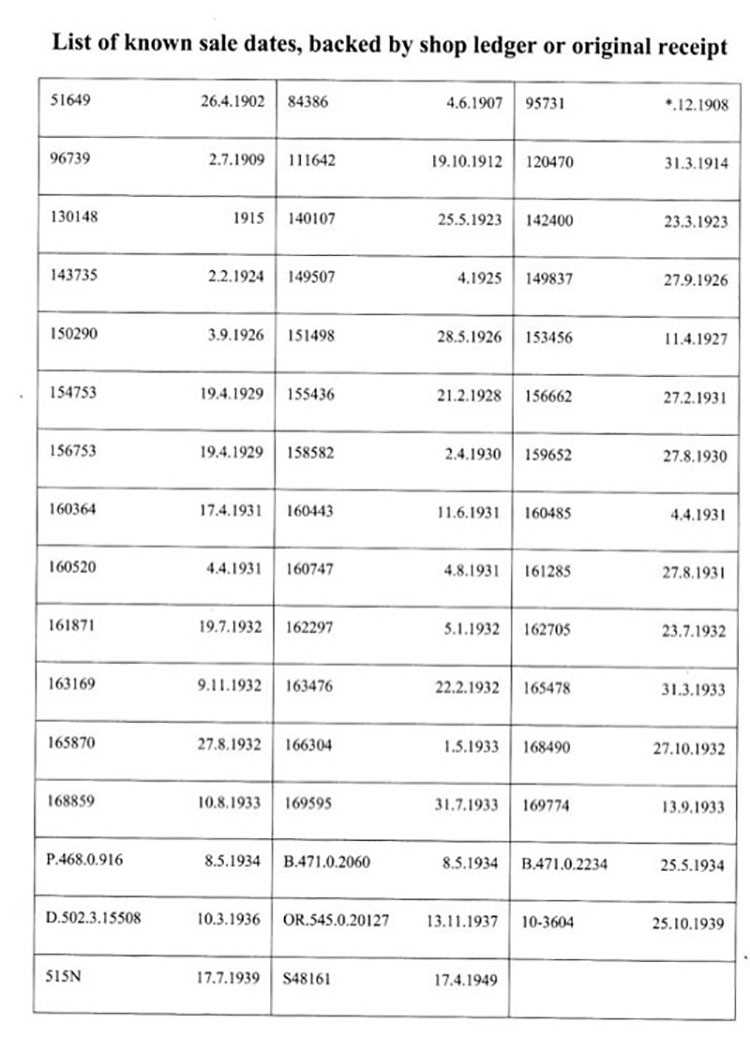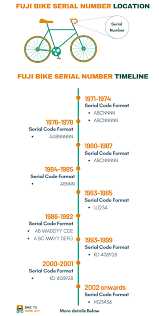
If you are a vintage bicycle enthusiast, you know that there is something special about riding a classic bike. Whether it’s the timeless design, the craftsmanship, or the nostalgia it brings, vintage bicycles hold a special place in our hearts. One way to dive deeper into the history of your classic bike is through a serial number lookup.
A serial number is a unique identifier that is assigned to each bicycle during its manufacturing process. It serves as a way to track the bike’s history, including the year it was made, the manufacturer, and sometimes even the specific model. By using a serial number lookup tool, you can uncover fascinating details about your vintage bicycle.
With the rise of online databases and forums dedicated to vintage bicycles, finding the history of your classic bike has never been easier. Simply enter your bicycle’s serial number into a lookup tool, and you’ll be presented with a wealth of information. From the original manufacturer to any modifications or repairs made over the years, you can piece together the story of your vintage bicycle.
Whether you’re a seasoned collector or just starting your journey into the world of vintage bicycles, a serial number lookup is a valuable tool. It allows you to connect with other enthusiasts, learn more about the history of your classic bike, and gain a deeper appreciation for the craftsmanship and design of these timeless machines.
Contents
Vintage Bicycle Serial Number Lookup

If you have a vintage bicycle and you want to learn more about its history, a serial number lookup can provide you with valuable information. The serial number of a bike is like its unique identifier, allowing you to trace its origins and understand its story.
Performing a serial number lookup is relatively simple. Start by locating the serial number on your vintage bicycle. This number is typically engraved or stamped on the frame, near the bottom bracket or on the rear dropout. Once you have found the serial number, you can begin your search.
There are several online databases and forums dedicated to vintage bicycles that offer serial number lookup services. These resources allow you to enter the serial number and retrieve information about the make, model, and year of your bike. Some databases even provide additional details such as the original color, components, and any notable features.
When using a serial number lookup tool, it’s important to keep in mind that not all vintage bicycles will have information available. Some bikes may be too old or rare to be included in the databases. However, it’s still worth giving it a try as you may uncover some interesting details about your classic bike.
In addition to online resources, you can also consult vintage bicycle experts and collectors. They may have extensive knowledge and experience in identifying and dating vintage bicycles based on their serial numbers. Local bike shops specializing in vintage bikes can also be a valuable source of information.
By conducting a serial number lookup, you can uncover the hidden history of your vintage bicycle. Whether you’re a collector, enthusiast, or simply curious about your bike’s origins, this process can provide you with a deeper appreciation for your classic ride.
Find the History of Your Classic Bike
If you own a vintage bicycle and want to learn more about its history, you can use a serial number lookup. The serial number is a unique identifier that can provide valuable information about your classic bike, such as its manufacturer, model, and production year.
To begin your search, locate the serial number on your vintage bicycle. The location of the serial number can vary depending on the make and model of your bike. Common places to find the serial number include the bottom bracket, head tube, or rear dropout.
Once you have found the serial number, you can use an online serial number lookup tool to access a database of vintage bicycle information. These tools are often provided by bicycle enthusiasts, collectors, or manufacturers, and they allow you to enter your serial number and retrieve the corresponding details about your classic bike.
When using a serial number lookup tool, it’s important to enter the serial number accurately to ensure accurate results. One small mistake can lead to incorrect information, so double-check the number before submitting your search.
After entering the serial number, the lookup tool will generate a report with information about your vintage bicycle. This report may include details such as the manufacturer’s name, the model name or number, the production year, and any other relevant information that is available.
Keep in mind that not all vintage bicycles will have detailed information available through a serial number lookup. Some older bikes may have limited records, and certain manufacturers may not have comprehensive databases. However, a serial number lookup is still a valuable tool that can provide insights into the history of your classic bike.
By using a serial number lookup, you can uncover the story behind your vintage bicycle. Whether you are a collector, enthusiast, or simply curious about the origins of your classic bike, this tool can help you piece together the puzzle and discover the history that lies within.
| Benefits of using a serial number lookup: |
|---|
| 1. Identify the manufacturer of your vintage bicycle |
| 2. Determine the model name or number |
| 3. Find out the production year |
| 4. Access any other available information about your classic bike |
| 5. Uncover the history and story behind your vintage bicycle |
Why Serial Numbers are Important
Serial numbers play a crucial role in the identification and history of vintage bicycles. They provide a unique identifier for each individual bike, allowing owners and enthusiasts to trace its origin, manufacturing details, and even its previous owners.
When conducting a serial number lookup for a vintage bicycle, you can uncover valuable information about the bike’s brand, model, and production year. This information can help you determine the authenticity and rarity of your classic bike, as well as its potential value in the market.
Serial numbers also serve as a useful tool in preventing theft and aiding in the recovery of stolen bicycles. By registering your vintage bike’s serial number with local law enforcement or online databases, you increase the chances of it being returned to you in the event of theft.
Additionally, serial numbers can be essential for warranty purposes. Some vintage bicycle manufacturers may still honor warranties or provide support for their older models, but they require the serial number to verify the authenticity and age of the bike.
It’s important to note that the format and location of serial numbers can vary depending on the brand and era of the vintage bicycle. Common locations include the bottom bracket shell, rear dropout, or head tube. Understanding where to find and how to interpret these serial numbers is crucial when performing a lookup.
| Brand | Serial Number Format | Location |
|---|---|---|
| Brand A | XX-XXXXX | Bottom bracket shell |
| Brand B | XXXXX | Rear dropout |
| Brand C | XX-XXXX | Head tube |
By understanding the importance of serial numbers and knowing how to perform a serial number lookup, vintage bicycle owners can gain valuable insights into the history and value of their classic bikes. Whether you are a collector, enthusiast, or simply curious about the origins of your vintage bicycle, serial numbers provide a key piece of information in unlocking its story.
How to Locate the Serial Number
When conducting a vintage bicycle serial number lookup, it is important to know where to find the serial number on your classic bike. The serial number is a unique identifier that can provide valuable information about the history and origin of your bicycle.
The location of the serial number can vary depending on the make and model of the bicycle. Here are some common places to look for the serial number:
| 1. Frame: | Check the underside of the bottom bracket shell, where the pedals and crankset are attached. The serial number is often stamped or engraved here. |
| 2. Head tube: | Look on the front of the frame, where the fork is attached. The serial number may be located on the head tube or the head badge. |
| 3. Seat tube: | Inspect the seat tube, which is the vertical tube that holds the seat post. The serial number may be located on the bottom or top of the seat tube. |
| 4. Rear dropout: | Check the rear dropouts, where the rear wheel attaches to the frame. The serial number may be stamped or engraved on one of the dropouts. |
Once you have located the serial number, you can use it to perform a vintage bicycle serial number lookup. There are online databases and resources available that can help you find the history and information about your classic bike based on its serial number.
Remember to record the serial number in a safe place, as it can be useful for insurance purposes or in case your bicycle is ever lost or stolen. By knowing where to locate the serial number and how to use it for a lookup, you can uncover the fascinating history of your vintage bicycle.
Using Online Databases for Lookup

If you have a vintage bicycle and want to find out more about its history, using online databases can be a great way to start your search. These databases are specifically designed to help you find information about your vintage bicycle by using its serial number.
There are several online databases available that specialize in vintage bicycle lookup. These databases collect and store information about different bicycle models and their corresponding serial numbers. By entering the serial number of your vintage bicycle into one of these databases, you can easily access information about its manufacturer, year of production, and other relevant details.
Using an online database for lookup is a straightforward process. First, you need to find a reliable vintage bicycle database. Some popular options include Bike Index, Vintage Trek, and Vintage Cannondale. Once you have chosen a database, navigate to their website and look for the search function.
Next, enter the serial number of your vintage bicycle into the search bar and initiate the lookup. The database will then search its records and display any relevant information associated with that serial number. This information may include the manufacturer, model name, year of production, and even historical advertisements or brochures.
Keep in mind that not all vintage bicycles may be listed in online databases. However, these databases are continually growing and updating their records, so it’s worth checking multiple sources if you don’t find any results initially.
In addition to online databases, you can also join vintage bicycle forums and communities to connect with other enthusiasts who may have valuable information about your vintage bicycle. These forums are a great place to ask questions, share pictures, and learn more about the history of your classic bike.
Using online databases for vintage bicycle lookup can be an exciting and informative process. It allows you to uncover the hidden history of your classic bike and connect with other enthusiasts who share your passion. So, if you have a vintage bicycle with a serial number, start your lookup today and discover the fascinating story behind your two-wheeled treasure.
Understanding the Serial Number
When it comes to vintage bicycles, the serial number is an important piece of information that can help you uncover the history of your classic bike. The serial number is a unique identifier that is assigned to each bicycle, providing valuable details about its origin, manufacturer, and production year.
By performing a lookup using the serial number of your vintage bicycle, you can gain access to a wealth of information that can help you understand more about your bike’s heritage. This includes details such as the brand, model, and even the specific factory where it was produced.
The format of serial numbers can vary depending on the manufacturer and the era in which the bicycle was made. Some vintage bicycles may have a simple serial number consisting of a combination of letters and numbers, while others may have a more complex alphanumeric code.
It’s important to note that not all vintage bicycles have serial numbers, especially those made before a certain time period or by smaller, lesser-known manufacturers. However, if your vintage bike does have a serial number, it can be a valuable tool in uncovering its history.
When performing a lookup, it’s helpful to gather as much information about your vintage bicycle as possible. This includes any markings, logos, or distinctive features that can help narrow down the search results. Additionally, knowing the approximate age of your bike can also be useful in finding accurate information.
There are various online resources and databases that specialize in vintage bicycle serial number lookups. These websites often have extensive catalogs and archives of serial numbers, allowing you to search for your specific model and find detailed information about its production history.
Understanding the serial number of your vintage bicycle can provide you with a fascinating glimpse into its past. Whether you’re a collector, enthusiast, or simply curious about the origins of your classic bike, performing a lookup using the serial number can be a rewarding experience that helps you uncover the rich history behind your vintage treasure.
Decoding the Manufacturer
When performing a vintage bicycle serial number lookup, it’s important to understand how to decode the manufacturer information. The serial number on a vintage bicycle can provide valuable insights into its history and origin.
The first step in decoding the manufacturer is to identify the brand or company associated with the bicycle. This can often be found by searching for the name or logo on the frame or components of the bike. Once you have identified the manufacturer, you can begin to gather information about the bike’s history.
Some vintage bicycles may have a serial number that includes a date code, which can help determine the year of manufacture. This can be especially useful when trying to determine the authenticity of a classic bike or when researching its value. Look for any numbers or letters that may indicate the year of production.
Additionally, the serial number may provide information about the specific model or series of the bicycle. This can help you find more detailed information about the bike, such as its original specifications or any unique features it may have had.
It’s important to note that not all vintage bicycles will have easily decipherable serial numbers. Some manufacturers may have used complex coding systems or may not have consistently recorded serial numbers. In these cases, it can be helpful to consult with experts or online forums dedicated to vintage bicycles to gather more information.
Decoding the manufacturer information is an essential step in conducting a vintage bicycle serial number lookup. By understanding the brand, year, and model of your classic bike, you can gain a deeper appreciation for its history and value.
Interpreting the Production Year

When it comes to vintage bicycles, one of the most important pieces of information you can gather is the production year. Knowing the year in which your classic bike was manufactured can provide valuable insights into its history and value.
The production year of a vintage bicycle can often be determined by decoding the serial number. The serial number is a unique identifier that is typically stamped or engraved on the frame of the bike. By understanding how to interpret this number, you can uncover the hidden secrets of your classic bike’s past.
It’s important to note that the format of serial numbers can vary depending on the manufacturer and the era in which the bicycle was produced. However, there are some general guidelines that can help you decipher the production year.
First, look for any letters or numbers at the beginning or end of the serial number. These characters often indicate the year of production. For example, a serial number starting with “A” might indicate that the bike was produced in 1964, while a serial number ending with “9” might suggest a production year of 1979.
In addition to the letters or numbers at the beginning or end of the serial number, you should also pay attention to the overall structure of the number. Some manufacturers use a specific pattern or code to signify the production year. For example, they might use the first two digits to represent the year, followed by a letter or number to indicate the month of production.
Decoding the production year of a vintage bicycle can be a fascinating detective work. It allows you to piece together the puzzle of its history and understand its significance in the world of classic bikes. So, grab your magnifying glass and start deciphering those serial numbers to unlock the secrets of your vintage bicycle’s production year!
Uncovering Unique Features

When it comes to vintage bicycles, each one has its own unique features that set it apart from the rest. One of the most important aspects of a vintage bicycle is its serial number. This number can provide valuable information about the history and origins of the bike.
The serial number is a unique identifier that is typically stamped or engraved onto the frame of the bicycle. It serves as a way to track the production and distribution of the bike. By decoding the serial number, you can uncover information about the manufacturer, the year of production, and even the specific model of the bicycle.
One of the interesting aspects of vintage bicycles is that different manufacturers had their own unique ways of assigning serial numbers. For example, some manufacturers used a combination of letters and numbers, while others used only numbers. This means that each serial number tells a different story, and it’s up to you to uncover its secrets.
When analyzing a vintage bicycle’s serial number, it’s important to pay attention to any unique features that may be present. These features could include special markings, engravings, or even custom paint jobs. By documenting and researching these unique features, you can gain a deeper understanding of the bicycle’s history and significance.
So, if you have a vintage bicycle and want to learn more about its history, start by examining its serial number. Take note of any unique features and do some research to uncover the story behind your classic bike. You may be surprised by what you discover!

Since childhood, I’ve been fascinated with vintage scooters and motorcycles. After university, I founded a workshop that restored classics like Vespas, Lambrettas, and MZs. With my girlfriend, Akiko Tanaka, I run the workshop’s website and showcase our custom restorations at iconic rallies across Europe and North America. Our Lambretta won first place at the 2019 Euro Lambretta meet in Germany. Through our website and global events, we share our passion for restoring and riding these retro rides.
